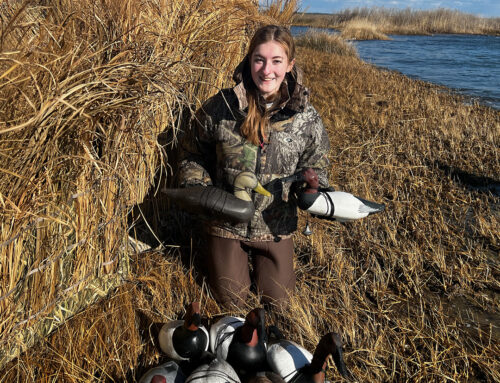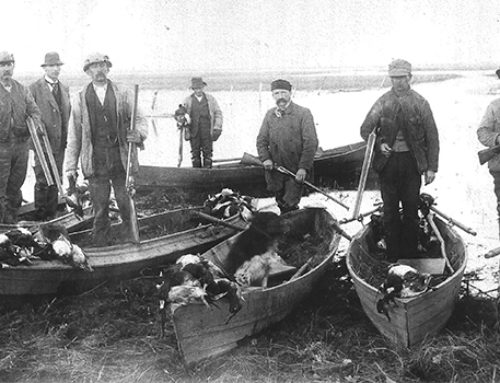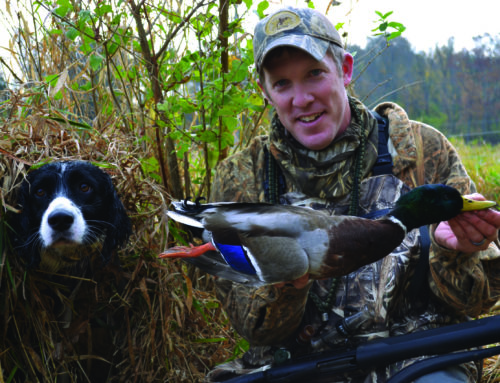Seeking Sprig In Sac Valley
California proves it’s the place to be for bull pintails

Story and Photos By Paul Wait
A torrent of raindrops stung my cheeks while whitecaps whipped our chosen water into a murky froth. We struggled to keep hats on our heads as we walked gingerly down the levee to a neatly hidden pit blind halfway from each end of the flooded rice field. We lifted the heavy lids and slipped down into the box to cover up—a welcome respite from the wicked weather.
Soon settled in, we loaded our shotguns and peered out: churning water in front, roiling water behind, a spitting sky and gale-force wind everywhere.
Oh, we had no complaints, especially after the show that was about to flash across this little piece of the Sacramento Valley. It’s just not how I had envisioned my first day of duck hunting in California.
For the next two hours, wave after wave of pintails—the drakes dressed in tuxedo-like December plumage—battled the relentless wind to wing over our field. Waiting for them to swing close enough to the blind for a shot quickly became part wonderment and another part torture. Turns out that ducks, even sleekly shaped fowl such as pintails, just don’t fly very fast against a 40 to 50 mph wind.
But those same ducks, the instant they spot danger, turn and quickly depart to distances well beyond the effective range of steel shot. I don’t know the exact math on it, but that experience proved that a 50-mph tailwind propels a duck past 40 yards in a blink. After several failures on too-far shots, we changed up our tactic: We allowed the ducks to fly much closer before we moved, and even then, we attempted to shoot without standing up to minimize detection for as long as possible. I don’t think I’ve ever passed up more ducks in range, especially not pintails.
A thousand pintails had winged within 100 yards, and most of them within 50 yards, before I finally connected on a handsome bull sprig. In a slight wind, we’d have been done in five minutes. Possibly faster. Of course, the ducks might not have flown as well then, either.
All of that happened during an extra day of hunting before the Delta Decoy Hunt. Because of an airline scheduling anomaly, I had arrived early. I returned to the lodge thoroughly soaked and rightly humbled, but I felt so fortunate: A bonus pintail is always a good omen.
Breaking Out the Rig
Rain pounded the Sacramento Valley all night, and local morning weathercasters warned of closed roads in the nearby mountains that had received 6 feet of snow. An 8-foot-ditch that a day earlier held a trickle of water was out of its banks as Mike Cole steered his truck down a long driveway toward the Chesapeake Gun Club in rural Yuba City, California. Had the water been any deeper, it would have breached the truck’s floorboards.
“We’ll just keep the truck doors closed,” Cole deadpanned. “We have waders if we need them.”
Cole, a successful California rice farmer, land manager and duck club owner, had graciously offered to host the 2021 Delta Decoy Hunt, our ninth annual event. Originally, event co-host Pat Gregory and I had planned California as the 2020 hunt destination, but COVID-19 concerns caused us to alter our schedule. We enjoyed a close-to-home bluebill hunt on Green Bay for the 2020 Decoy Hunt, and pushed pintails in California back a year.

Jason Tharpe, chief development officer for Delta Waterfowl, had business in California that coincided with the hunt dates. Blinds are set up for three hunters at the Chesapeake Club, so Tharpe, Cole and I teamed up in one blind, while Gregory hunted a nearby blind with Cole’s son-in-law, Lance Matteoli , and Vic Sutek, a friend and decoy carver from Ohio.
The marsh at the Chesapeake Club had risen so much, staying within the navigation channels proved tough, and wedging the boat under the hide attached to our blind took real effort. After setting a pod of specklebelly decoys, we brought out the nine hand-carved pintail decoys.
“The ducks usually come from the Sutter National Wildlife Refuge, which is just over the trees there,” Cole explained as Tharpe stretched out the anchor lines on an expertly crafted pair of Rob Capriola decoys. “Let’s set them off the right corner of the blind.”
Wings whistled overhead as we placed the last of our celebrity pintails and slid into the brush-covered blind. A pair of mallards whipped past. Wigeon and shovelers circled, and a few teal flitted about. Snow geese cruised noisily high overhead, too. A scant few ducks gave us a look, but the pintails we coveted were somewhere else.
We shot a couple of wigeon and shovelers, and never had a chance at a pintail. Gregory and the others had similar luck. According to Cole, the action was slow for a well-managed California duck club in the heart of the Sacramento Valley.
“A lot of ducks migrated right past this area because of the drought,” he said. “The water was put on the refuge late, so we aren’t holding as many ducks.”

A New Day
We were right back at the Chesapeake Club the next morning. Hunting pressure is carefully managed, so they only gun it three days a week: Tuesdays, Wednesdays and Saturdays.
Cole picked a different blind, and we arrived with renewed optimism. Today, Cole had brought his best retriever, a block-headed Chessie named Banded. Our duck dog seemed eager to go to work, and swam around outside the blind as we set our hand-carved pintails right out front, an easy 20-yard shot should they pull birds.
“It’s shooting time,” Cole proclaimed. “We’d better get ready.”
A drake wigeon locked and began to circle the spread as we scrambled to stuff shells into our shotguns. The duck cupped in beautifully on my end of the blind. Finger on my safety, I was just about the rise and fire when Cole whisper-shouted, “Right above us!”
A flock of regal ducks 20 strong flared straight up, right, left and behind as Cole and Tharpe came up firing. I lost track of the lone wigeon and found another duck in the melee.
Pintails! my mind screamed as the ducks reached for the safety of the fluffy clouds above.
Three ducks splashed to the surface, and at Cole’s prompt, Banded powered into the job of finding and fetching. The sun’s first Wednesday rays shimmered across the water as Cole’s retriever swam back with a big sprig clamped in his jaws.
Two minutes into our hunt, we’d each met our daily limit of one pintail. For the ninth straight Delta Decoy Hunt, we had shot the target species over the specially assembled rig.
“How about that?” Cole chided as he stepped back into the blind to take the drake from his dog. “We’ll take it.”
Unlike the previous day, ducks were interested in decoying, once again proving the notion that no two days of waterfowl hunting are ever the same. We were watching a pair of mallards when a lone duck nearly pitched into the pintail decoys. I moved, so the duck flared. It was an easy shot, but one I couldn’t take. Bull pintail, proudly stretching his dark chocolate head and long spear of a tail—the kind of prime specimen that often ends up at a taxidermist.
“Oh wow” I groaned.
Tharpe reacted, too.
“That was a nice drake,” he confirmed. “Looked like he was going to land right in the carved decoys.”
Over the next two hours, several flocks of pintails worked the rig, including a trio that whistled past just above our hats. The sprig showed off while we admired the splendor of a Sacramento Valley morning in the blind. We added a few wigeon, a mallard and a drake gadwall to our straps, and Banded was happy to swim for them.
“I’m glad it worked out,” Cole said with a wry smile back at the boat shed. “Not as many ducks as we normally see, but we got our pintails, and they were right over the decoys. That’s hunting in California.”

Banded, the duck dog made quick work of the wigeon and pintails felled by the hunters.
Your Chance for a Pintail Decoy
We thoroughly enjoyed a memorable hunt over this amazing rig of masterfully carved pintail decoys. But now, these birds have more work to do.
Each decoy is a gunning bird that floats perfectly and presents beautifully on the water. All were carved and painted with craftsmanship worthy of year-round display on office desks, fireplace mantels and as duck club decor during the offseason.
The seven skilled carvers—all of whom are profiled on the following pages—have generously donated their decoys to raise money for Delta Waterfowl programs. These birds will be auctioned at selected Delta events in the coming months.
Now it’s your turn to participate in the 2021 Delta Decoy Hunt. Look for announcements about how you can bid on these unique pintail decoys to support Delta Waterfowl.
Paul Wait is senior manager of communications for Delta Waterfowl.












Leave A Comment